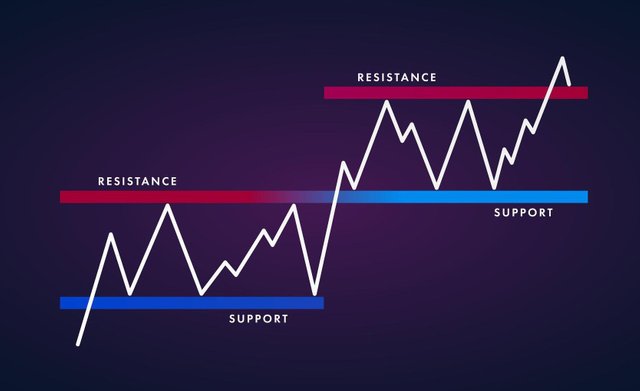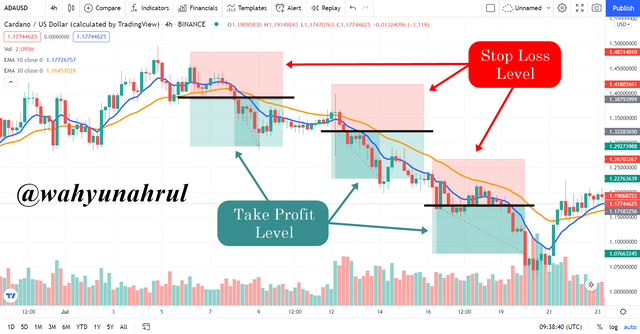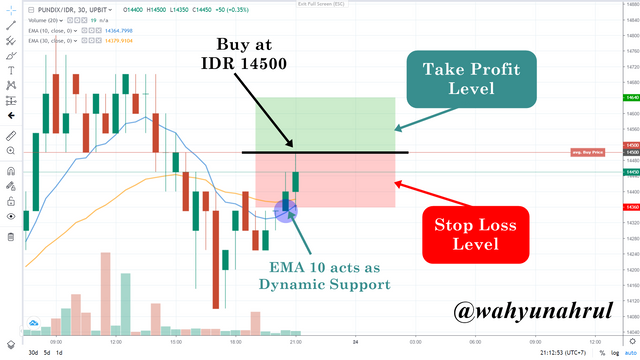Hey Guys..!!
Meet again with me Wahyu Nahrul on the other Steemit Crypto Academy homework. Today I will be working on homework given by one of our professors @cryptokraze.
The homework given by our professor this week is about Trading The Dynamic Support & Resistance.

Okay, just get to the discussion. Happy Reading !!

The Concept of Dynamic Support and Resistance
As we already know that Support and Resistance is a certain price area of a cryptocurrency that is used as a benchmark for making decisions in trading. Support and resistance levels are usually made by drawing a straight line at the lowest or highest point on a cryptocurrency chart, if the price of a cryptocurrency touches the trendline, the price is likely saturated and will reverse direction. However, this cannot be used as a benchmark because the price of cryptocurrencies is very volatile and often crosses the trendline that has been created and will create a new trendline.
However, there is a trendline type that we can use without having to draw a new line if the price of a cryptocurrency crosses a previously created trendline, this type of trendline is "Dynamic Support and Resistance".
Dynamic Support and Resistance doesn't need to draw a manual trendline on the chart, we will use a tool called "Exponential Moving Average (EMA)" which will act as a trendline at support and resistance levels and become our benchmark for making decisions in trading.
EMA acts as Dynamic Support

In this example, I will take a graph of the SOLANA coin with a 4-hour timeframe. Previously I have discussed that if the graph of the cryptocurrency touches the trendline, it is most likely that the price of the cryptocurrency will reverse direction, you can also see this in the image above if we look at the graph shown by the arrows on the graph, we can see each candle that touches the EMA line which acts as support then it will reverse direction towards the top.
EMA acts as Dynamic Resistance

And this also happens the other way around, if the trend is entering a bearish phase then the EMA line which acts as a trendline will reverse direction and will be above the candlestick, the EMA will become a resistance line where if the candlestick touches the EMA line it will bounce back down. You can see this at several points indicated by the arrows in the chart above, almost every candle that has touched the EMA line will return to the opposite direction.

Combination of 10 and 30 EMAs as Dynamic Support and Resistance
Alright, after the previous discussion I showed how an EMA line can be a trendline that can be used as support and resistance, this time I will show you how to combine 2 different EMA lines and make them trendline support and resistance when trading.
The first EMA line I take is the 10 EMA which will be shown in Blue.

And another one I chose 30 EMA which will be shown in Orange.

10 and 30 EMAs Act as Dynamic Support

In this example, I take Polkadot with a timeframe of 4 hours. As you can see in the picture above that where the trend is Bullish, the candlestick will be dominant above the 10 and 30 EMAs lines, even when the candle touches one of the EMA lines it will bounce up as if away from the line. Indeed there are several times the candlestick crossed the 10 and 30 EMAs, but it was only for a moment and it would return above the 10 and 30 EMAs.
10 and 30 EMAs Act as Dynamic Resistance

On the other hand, in the bearish phase, the candlestick will be below the 10 and 30 EMA. As in the previous bullish phase, the candlestick will also bounce if it touches the 10 and 30 EMA lines, this proves that the EMA line can be trusted as a resistance line.

Trade Entry and Exit Criteria for Both Positions
In this discussion, I will discuss how we use the 10 and 30 EMA as our benchmark for Entry and Exit in 2 positions, namely Buy and Sell. This will help us how to determine our entry and exit positions when trading. For the Entry example, I will use the chart from Ripple (XRP), and for the Exit, I will use the Cardano (ADA) chart, both use the same timeframe of 4 hours.
Trade Entry
1. Buy Position
To place a Buy position, there are several things that we must pay attention to first, including:
First, install two EMA lines on the cryptocurrency chart of your choice, here I use the 10 and 30 EMAs, try the EMA that you take has a slightly different length difference in order to give us 2 varied support options.
Make sure the ongoing trend is a "Bullish" trend. You can confirm this by looking at the position of the candlestick above the EMA line.
Wait until the lowest price on a candlestick touches the 10 EMA line and if it is still down then wait again until it touches the 30 EMA line.
Make a purchase if you see the candlestick after it bounces up and doesn't touch the EMA line again, you can place an order at the lowest possible price in order to get the maximum profit. However, do not be in a hurry to set a price, because it could be just a trick and the price can reverse direction in a very short time.
For more clarity, you can see it in the graph below.

2. Sell Position
To place a Sell position on the Entry criteria, there are several things that we must pay attention to first, including:
Just as before, we first install two EMA lines on the cryptocurrency chart of your choice, namely EMA 10 and 30.
Make sure the ongoing trend is a "Bearish" trend. You can confirm this by looking at the position of the candlestick which is below the EMA line.
Wait until the highest price on a candlestick touches the 10 EMA line and if it is still rising then wait again until it touches the 30 EMA line.
Make a sale if you see the candlestick after it bounces down and doesn't touch the EMA line again, you can place an order at the highest possible price in order to avoid minimum losses. However, do not be in a hurry to set a price, because it could be just a trick and the price can reverse direction in a very short time.
For more clarity, you can see it in the graph below.


Trade Exit
In contrast to Trade Entry, at Trade Exit we will do a trade where we will get profit in a trend, namely the Bullish and Bearish trend. Usually, this type of trading is Margin trading where we will determine the trend direction of a cryptocurrency and if we are correct in choosing it then we will get profit in both trend conditions. And as before we will use 2 different EMAs as Support and Resistance
1. Buy Position
To place a Buy position, there are several things that we must pay attention to first, including:
First, install two EMA lines on the cryptocurrency chart of your choice, here I use the 10 and 30 EMAs, try the EMA that you take has a slightly different length difference in order to give us 2 varied support options.
Make sure the ongoing trend is a "Bullish" trend. You can confirm this by looking at the position of the candlestick above the EMA line.
Put Take Profit and Stop Loss Levels on the chart, here according to the direction of professor @cryptokraze I will put Take Profit and Stop Loss Levels in a 1:1 ratio.
Make sure the Stop Loss Level is below the largest EMA, which is the 30 EMA.
Wait until the lowest price on a candlestick touches the 10 EMA line and if it is still down then wait again until it touches the 30 EMA line.
Make a purchase if you see the candlestick after it bounces up and doesn't touch the EMA line again, you can place an order at the lowest possible price in order to get the maximum profit. However, do not be in a hurry to set a price, because it could be just a trick and the price can reverse direction in a very short time.
If the price has entered the Take Profit area, then do the seller in order to get a profit. Don't be too greedy by wanting a bigger profit, control your emotions so you can play with a relaxed head.
Conversely, if you have made a purchase and the price is below the 30 EMA as well as the Stop Loss level, then immediately sell the cryptocurrency to avoid big losses.
For more clarity, you can see it in the graph below.

2. Sell Position
To place a Sell position on the Exit criteria, there are several things that we must pay attention to first, including:
Just as before, we first install two EMA lines on the cryptocurrency chart of your choice, namely 10 and 30 EMAs.
Make sure the ongoing trend is a "Bearish" trend. You can confirm this by looking at the position of the candlestick which is below the EMA line.
Put Take Profit and Stop Loss Levels on the chart, here I will put Take Profit and Stop Loss Levels with a 1:1 ratio.
Wait until the highest price on a candlestick touches the 10 EMA line and if it is still rising then wait again until it touches the 30 EMA line.
Make a purchase if you see the candlestick after it bounces down and doesn't touch the EMA line again, you can place an order at the highest possible price in order to get the highest possible profit. However, do not be in a hurry to set a price, because it could be just a trick and the price can reverse direction in a very short time.
If the price has entered the Take Profit area, then do the seller in order to get a profit. Don't be too greedy by wanting a bigger profit, control your emotions so you can play casually.
Conversely, if you have made a purchase and the price reverses past the 30 EMA as well as the Stop Loss level, then immediately sell the cryptocurrency to avoid big losses.
For more clarity, you can see it in the graph below.


Two Demo Trades on Crypto Assets
In this last part, I will practice directly how to use 2 types of EMA when trading. I will trade on an exchange called Upbit Indonesia, there are 2 cryptocurrencies that I take as an example, namely Litecoin and Pundi X, both use a 30-minute timeframe and I will use the Trade Exit method on Buy positions as explained in the previous discussion.
1. LTC/IDR

Just like the previous examples, this time I use the EMA 10 and 30 as Resistance. In the chart above it is shown that the lowest price of the previous candlestick has touched the EMA 10 line which is Resistance. After that, I immediately made a Buy order at the exact price of IDR 1,750,000. After that, I made Take Profit and Stop Loss levels with a ratio of 1:1.


2. PUNDIX/IDR

Next, I took another example, namely Pundi X. Just like before I also used the EMA 10 and 30 as Resistance, then in the chart above we can see that the lowest price of the previous candlestick has touched the EMA 10 line as well as Litecoin earlier, after that I immediately made Buy orders at the exact same price IDR 14,500. Then I also made Take Profit and Stop Loss levels with a ratio of 1:1.


Last Word (Conclusion)
Dynamic Support and Resistance is a very good thing if applied when trading, traders do not need to manually create Support and Resistance lines and do not need to re-analyze if there is a change in the trendline because Dynamic Support and Resistance use EMA which is a line that represents average fluctuations The average price of a cryptocurrency in real-time, so it is very good to be used as a benchmark for Support and Resistance.
Those are some of my explanations regarding trading with Dynamic Support & Resistance, I apologize if there are still many mistakes that you can get when reading my explanation earlier, I would be very grateful if you told me in the comments column below.
Thank you for reading my blog, hope it will be useful for all of you. 😁


Dear @wahyunahrul
Thank you for participating in Steemit Crypto Academy Season 03 and making efforts to complete the homework task. You got 9/10 Grade Points according to the following Scale;
Key Notes:
We appreciate your efforts in Crypto academy and look forward for your next homework tasks.
Regards
@cryptokraze
Downvoting a post can decrease pending rewards and make it less visible. Common reasons:
Submit